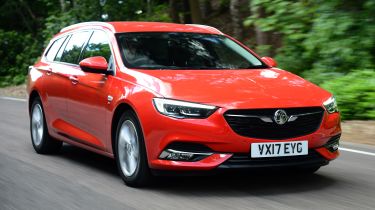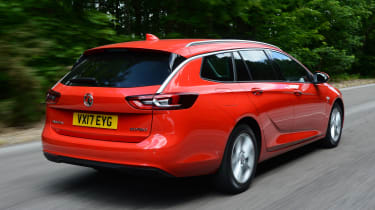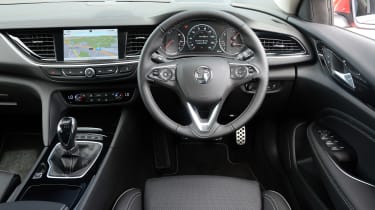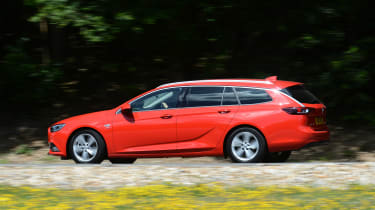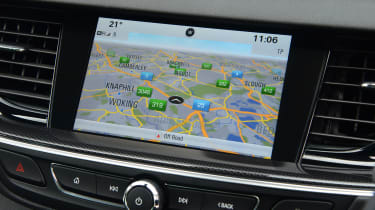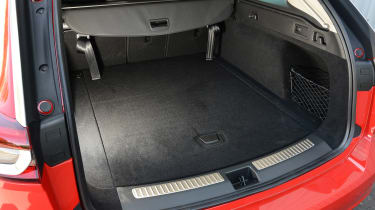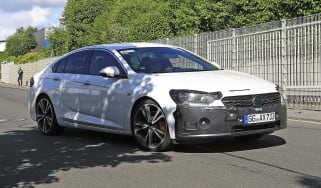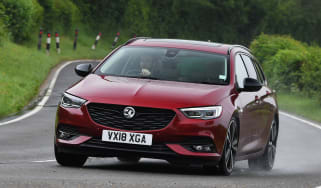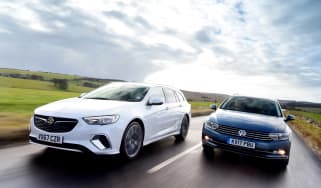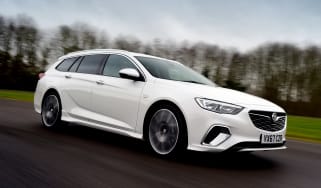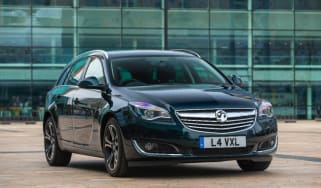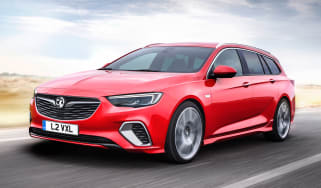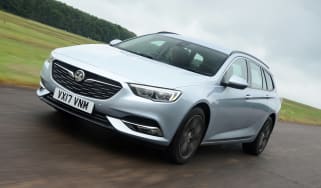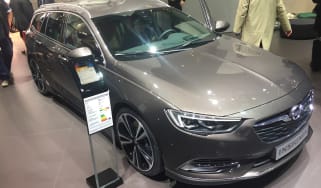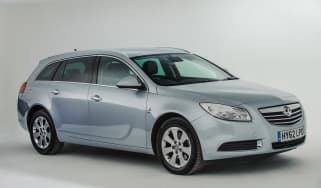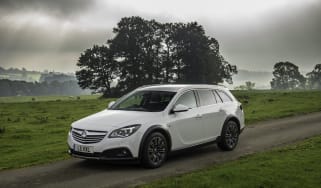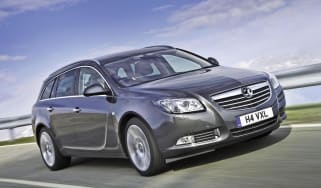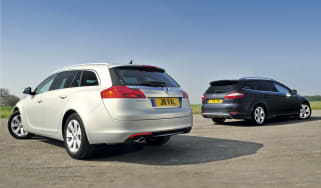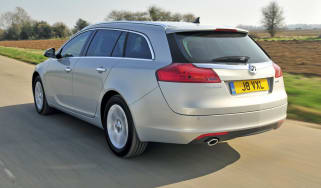Vauxhall Insignia Sports Tourer (2017-2019) review
The Vauxhall Insignia Sports Tourer is a comfortable and competent load-lugger that gives pricier premium rivals a run for their money

The traditional large family car has been under attack for years. First it was people carriers and MPVs, while more recently the wave of fashionable crossover and SUV models has been sucking sales out of the sector. That’s especially true if we’re talking about rivals for practical estate models.
It means the Vauxhall Insignia Sports Tourer has a tough fight on its hands, and not only from obvious competitors such as the Ford Mondeo, Mazda 6, Skoda Superb and Volkswagen Passat estates. Potential customers may also be eyeing up a range of SUV models like the Kia Sorento, Skoda Kodiaq or Nissan X-Trail. Of course higher-spec models also have to contend with a range of rivals with ‘premium’ badge, like the Audi A4 Avant, BMW 3 Series Touring and Mercedes C-Class Estate, too.
The Vauxhall Insignia Sports Tourer enters the fray well-equipped for the fight, however. It’s noticeably bigger than the previous version, yet retains its stylish, sporty profile. The Sports Tourer is one of only two models in the current Insignia line-up, the other being a five-door hatch called the Insignia Grand Sport. Previous Insignia generations featured a four-door saloon, but that was dropped mid-way through the last model cycle.
Engines and gearboxes are carried over from the Grand Sport hatch, so there’s no shortage of petrol or diesel power options. There’s also an eight-speed automatic gearbox, and the option of four-wheel drive on top models.
Used - available now

2022 MG
HS
12,807 milesAutomaticPetrol1.5L
Cash £16,287
2021 Citroen
C1
11,182 milesManualPetrol1.0L
Cash £9,487
2017 Vauxhall
Insignia
96,309 milesManualDiesel1.6L
Cash £4,500
2019 Land Rover
Range Rover Evoque
94,100 milesManualDiesel2.0L
Cash £8,750The Sports Tourer model line-up starts with the Design trim, but even that is well-equipped with a smartphone compatible touchscreen infotainment system with DAB radio, keyless entry, cruise control and autonomous emergency braking. You can also order a Design Nav version, with the obvious addition of sat-nav included.
Next up is the Sports Tourer SRI, which has sports seats and 17-inch alloys. A SRi Nav model is also available. The Tech Line Nav features rain-sensitive wipers and parking sensors, while the SRI VX-Line Nav has sports-style bumpers and big 18-inch alloys.
Beyond that is the Elite Nav, which comes with a suitably huge kit list: it gets Matrix LED lights, leather seats that are heated in in all but the centre rear seat, a digital display for the dials and another for the touchscreen infotainment system, which has Apple CarPlay and Android Auto. There’s also a front-facing camera that works with the forward collision alert and auto emergency braking, and lane departure warning with lane assist.
While the Elite Nav sits at the luxury peak in the range, the GSi is the sporty option. It comes with its own bespoke look and package of equipment, as well as stronger engines and sports suspension to make the most of the extra performance. Effectively, it replaces the VXR models from the previous Insignia, but it's a rather more subtle interpretation of what a high-performance Insignia should be.
As pleasant as these higher spec cars are to sit in and to drive, they cost too much to sensibly justify - at around £31,000 the Elite Nav, when equipped with the 168bhp diesel, is 50 per cent more expensive than the entry level Sports Tourer.
Finally, Vauxhall also offers another version based on the regular estate, called the Country Tourer. It’s a slightly jacked-up, four-wheel drive model designed to take the fight to some of those crossover/SUV rivals. It features a small 20mm ride height increase and some chunky black bodywork additions for more of a ‘lifestyle’ feel.
The Vauxhall Insignia Sports Tourer is a big, practical and eye-catching estate car that will work hard for company users and their families – without breaking the bank.
It will satisfy most owners with its surprisingly agile handling, supple ride and refined cruising ability, while its svelte styling hides a big load bay and spacious cabin. It’s worth noting that outright practicality can’t match the vast Skoda Superb Estate, however.
There’s a decent choice of petrol and diesel powertrains, all offering performance and economy. A five-star crash test rating is reassuring, too. Overall, the big Vauxhall is well-equipped, with pricing that will look especially attractive to anyone contemplating one of many German estate car rivals sporting more prestigious badges.
Engines, performance and drive
The latest Vauxhall Insignia line-up comes from a long tradition of family-sized cars designed with one primary goal: whizzing legions of corporate ‘execs’ up and down the nation’s motorway network from one meeting to the next.
In the case of the estate version, it also adds a welcome degree of versatility, with enough space for a boot full of cash registers, commercial samples or whatever else keeps the wheels of industry turning. These are all tasks the latest Insignia Sports Tourer handles with aplomb.
The cabin is refined and comfortable, with very little wind, engine or road noise. The Insignia offers an especially smooth ride at lower speeds, although bumps can be a little intrusive if you’re pushing harder. The overall ride quality is impressively compliant, and the handling surprisingly crisp for a car that feels this big. There’s a degree of body roll, but the steering is nicely weighted and you can place the car confidently in corners – just like the hatchback version.
The GSi does have a slightly firmer feel, but thanks to the FlexRide adaptive damping system, the driver can tailor the responses to give a surprisingly smooth ride. And, with standard four-wheel drive helping to give excellent traction, it's a car that feels tremendously sure-footed. The only weak link is the steering, which never provides enough feedback, meaning that the GSi isn’t a terribly engaging car to drive.
In fact, no Insignia Sports Tourer is an overly thrilling drive by any measure, and off the main road network the size of the car does affect the driving experience. It can feel cumbersome around town, especially when looking for a parking space. Backing up a tight country lane, you’re always aware of the huge load volume behind you, too.
Engines
The range of Insignia Sports Tourer engines is the same as the line-up in the hatchback, which means you’re offered a pair of 1.5-litre turbocharged petrol units and a choice of 1.6 and 2.0-litre diesels. The most powerful engine is a 257bhp 2.0-litre petrol in the GSi, which only comes with four-wheel drive. It’s punchy but doesn’t feel like a match for the muscle in the 278bhp flagship Skoda Superb.
Sticking with the petrols, it’s fair to say the most basic 138bhp 1.5 turbo can feel a little overwhelmed in the Insignia Sports Tourer, especially if you carry heavy loads. It means that, if you don’t want to run a diesel, the 163bhp version is the better bet.
Speaking of which, you can pick the 1.6-litre diesel with either 108bhp or 134bhp. The 2.0-litre version gets 168bhp, but meaty torque figures mean even the lower-powered version feels decently muscular; and, at the top of the range, the GSi has a bi-turbo diesel, which looks very good on paper, but is rather held back the slow responses of the eight-speed automatic gearbox. On the other hand, like the other diesels, it's quiet and economical.
MPG, CO2 and Running Costs
If you’re buying privately, there’s no doubt the practicality, relatively high spec levels, decent fuel efficiency and competitive pricing makes the Insignia Sports Tourer look good value for money. Buying used is a great idea, too, as you’ll suffer less in the way of depreciation and still get the same practicality and strong kit list.
However, most Insignia Sports Tourers are run by company car drivers, so it’s the car tax figures that are of most interest. The lowest powered 108bhp diesel version returns a claimed 64.3mpg on the combined cycle, and offers the best emissions with a 112g/km rating for CO2. This means you’ll be liable for a 24 per cent Benefit-in-Kind tax charge.
Jump to the 134bhp engine and you’ll still return 61.4mpg, but with CO2 emissions rising to 119g/km you’ll find BiK goes up to 25 per cent. Be careful if you want an auto gearbox, because there’s a significant economy penalty – down to 54.3mpg – while C02 jumps to 137g/km. That puts your BiK liability up to 29 per cent, which is the same level you’ll pay for the 2.0-litre 168bhp diesel, which records 53.3mpg and 139g/km. Swapping to an automatic model here means sub-50mpg figures and 150g/km, and a subsequent 32 per cent BiK charge.
The 1.5-litre petrol engines return 47.1mpg and 46.3mpg depending on whether you pick the 138bhp or 163bhp version, and both attract BiK of 26 per cent. In contrast the 256bhp four-wheel-drive petrol flagship manages only 32.5mpg and with 199g/km of CO2 will cost a chunky 37 per cent BiK.
Insurance groups
Insurance ratings for the Insignia Sports Tourer are not too bad, starting with Group 13 for the 108bhp entry-level diesel and rising to Group 25 for the 2.0-litre 256bhp 4x4 petrol model. Even the latter is pretty low, with flashier rivals posting much higher ratings.
Depreciation
You can expect Vauxhall Insignia models to lose more value over a typical three-year/36,000-mile ownership period than premium-badged rivals from Audi, BMW or Mercedes. We’d predict retained values of around 35-37 per cent of the new price for the Vauxhall, compared to 40+ per cent for the others.
Interior, design and technology
The latest Insignia range looks much more distinctive than before, and the Sports Tourer estate has some particularly novel styling features at the rear. All models share the broad new grille and swoopy LED front light styling, as well as a bonnet with an unusual centre-crease and heavily sculpted flanks. From the rear passenger doors back, the Sports Tourer has a style of its own and looks quite different to the Grand Sport hatch.
The rear roofline extends straight backwards without dipping, maximising load volume in the back. To help break up this expanse of metal, the upper window trim strips carve an increasingly divergent path from the roof rails from the front to the rear of the car. These continue across the rear pillar before dipping along the tailgate edges, and into a final reverse flourish in the rear light clusters.
The flagship GSi model has its own look, sitting 10mm lower than a regular model and, as you might expect, it has plenty of unique parts. The 20-inch alloys, bespoke bumpers and sills, LED headlights and gleaming exhaust pipes all make it stand out from lesser Insignias.
In any Sports Tourer, the interior is very similar to latest Vauxhall Astra’s, with a big central touchscreen flanking the instruments in a binnacle that extends over two thirds of the facia. There’s also a useful ledge to steady your hand against when operating the touchscreen, logical positioning for the heater and climate controls, and a sporty-looking three-spoke multifunction steering wheel.
The overall fit and finish is good, but Vauxhall should have gone for more tactile and luxurious plastic finishes if it wanted to rival premium brands for their higher quality feel.
Sat-nav, stereo and infotainment
All Insignia models are fitted as standard with an Intellilink infotainment system featuring Apple CarPlay and Android Auto. You also get WiFi included as part of the Vauxhall OnStar concierge service which is available on all models too.
The standard audio system can be upgraded to a BOSE setup, which is good but lacks the ultimate ‘wow’ factor of high-end systems in more premium rivals. The touchscreen infotainment system’s interface looks a little low-rent in comparison to some rivals too, although it packs in plenty of functionality.
Practicality, comfort and boot space
The Insignia Sports Tourer is a very different proposition to the previous-generation Insignia estate, which was widely criticised for a ‘style over substance’ design that meant you couldn’t get enough in it.
That’s definitely not the case this time around, as although you still get eye-catching rear styling, the bigger dimensions all round mean it doesn’t come at the expense of load space. The big-car dimensions means there’s plenty of room up front too, with roomy door bins and plenty of oddment spaces.
While the extra volume aids practicality, the Sports Tourer can feel like a big car on the road – especially in tight urban spaces. It’s a cumbersome car when reversing as well.
Size
There’s no particular magic to the Sports Tourer’s luggage swallowing ability – it’s simply a big car. The Vauxhall is 130mm longer than a Skoda Superb Estate in fact, at an impressive 4,986mm (almost five metres) nose-to-tail. The two cars are almost identical for width, too.
Leg room, head room & passenger space
Given the generous dimensions, it’s perhaps no surprise that the Sports Tourer offers seriously impressive space for all occupants. That’s especially so in the rear seats, which offer legroom that’s pretty much unbeatable in anything this side of a Mercedes S-Class. The high roof extending rearwards over the load bay means there’s no problem with headroom either.
Boot
This latest Insignia estate has a 135-litre advantage over its predecessor, and features a 1,665-litre load bay once the seats are electrically folded flat into the floor. It’s enough to trump the Ford Mondeo (1,605 litres), but it’s surpassed by the van-like interior of the Skoda Superb which swallows 1,950 litres.
With the seats up, the Sports Tourer still offers an impressive 560 litres, which compares favourably to the 525-litre Mondeo. It can’t match the 650+ litres of the Skoda Superb and VW Passat though.
Reliability and Safety
With all models getting autonomous emergency braking as standard, and anti-collision and lane departure warnings among the features on the option list, there’s no need to feel short-changed by the Sports Tourer’s safety kit. To prove the point, Euro NCAP gave the hatchback model a full five-star independent crash test rating, and they awarded an impressive 93 per cent score for adult crash safety. There’s no reason to believe the estate model wouldn’t achieve similar results as the two cars are identical at the front end.
If the worst does happen, we like the fact that Vauxhall’s OnStar concierge service is available as standard too. Linked to a mobile phone SIM card, subscribers will find their car able to communicate automatically with the control room if an accident is detected.
It’s a bit early to comment on the new Insignia’s reliability, but Vauxhall as a brand has had mixed reviews in our Driver Power Survey. The 2017 poll saw two of the brand’s cars – the Mokka X and Corsa – finishing very near the tail-end of the 75 car survey, and reliability and build quality were two areas where the performance was worst.
The new Astra did much better, recording a 27th place finish, so it must be hoped the Insignia scores will proceed in the same direction of travel.
Warranty
Vauxhall has yet to rise to the challenge set by the four, five and even seven-year warranties provided by some of its rivals. Its three-year/60,000-mile offer seems distinctly old-hat these days, though it’s no worse than the cover provided by Volkswagen Group brands (Skoda, SEAT, Audi etc), and many Japanese companies.
Servicing
The Insignia has variable servicing requirements depending on mileage, but you’ll need to visit for a check-up at least once every year. Fixed price servicing plans are available to help spread the cost, which we’d expect to be very competitive.
